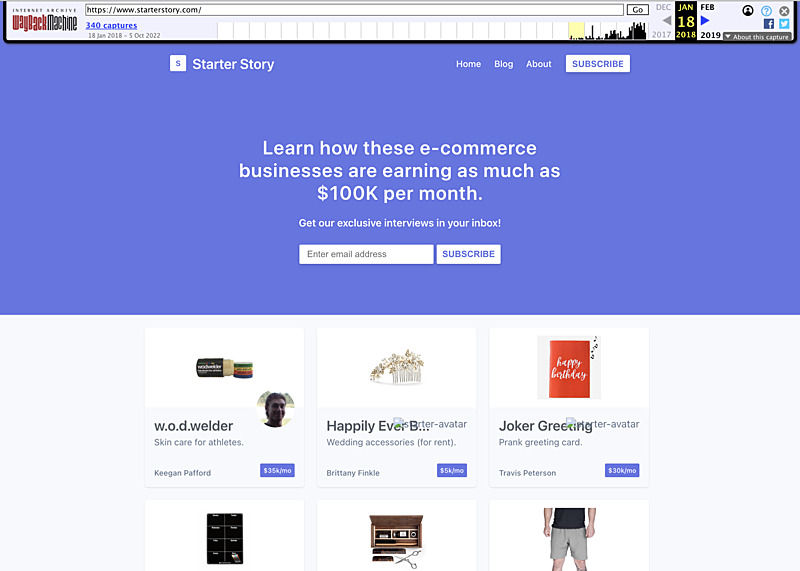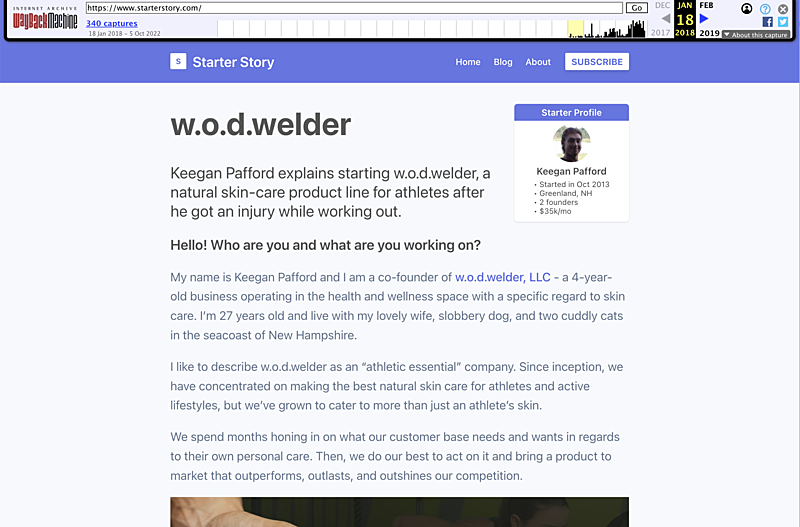October 5th, 2022
It’s officially been 5 years since I launched the original Starter Story website:
Yep, that’s starterstory.com, when I “launched” the website in 2017. And, of course, nobody visited it.
On the surface, it doesn’t look much different than it does now.
But behind the scenes, everything has changed. I’ve turned this little side project into a real business, with a real team.
Since I’ve been working on Starter Story for half a decade, I wanted to write a bit about the journey and some of my biggest lessons.
Before we jump in…
In case you didn’t know, Starter Story is a platform where founders share how they built their businesses.
Last month (September 2022), we made $74K in revenue, and over 1.5M people visited the website!
You’re probably wondering how Starter Story works as a business and how it makes money:
- Premium memberships (~38% of revenue): Members pay a yearly fee and get unlimited access to all of our case studies, databases, and other benefits
- Advertising and sponsorships (~57% of revenue): Companies pay us to advertise their product in our newsletter and our website.
-
Affiliate revenue (~5% of revenue): We get paid when a reader clicks an affiliate link on our website and signs up for something or makes a purchase.
A bit more details on each of our revenue streams:
1. Starter Story Premium Membership (~38% of revenue)
With about 2,500 active members, our paid subscription generates ~$30k/month on average.
Similar to the New York Times, you can read a limited number of case studies on our website per month, for free. But if you sign up and pay to be a member, you can read unlimited, plus you’ll get access to some of our databases (e.g. business ideas database).
2. Ads & Sponsors (~57% of revenue)
Companies pay us to advertise their products in our articles or on our newsletter. Our audience is niche, so brands will come to us, looking to get in front of our audience. We also go out and pitch brands as well.
3. Affiliates (~5% of revenue)
Our case studies & content often mention what products founders use, such as Shopify, Klaviyo, and thousands of other tools. If a reader clicks a link to these tools, we sometimes get a cut of the sale (if they buy). This is a smaller part of our revenue but we’re hoping to grow it (feedback welcome).
Early traction: celebrate and zone in on the smallest wins
I started Starter Story as a side project (while I had a full-time job).
I’ve had many other projects that have failed...
What I’ve learned through these failures: the hardest part about building a side project is not giving up.
IMO the best way to not give up is to work as hard as you can to achieve some small traction or small positive reinforcement in the early days.
This traction doesn’t have to be life-changing, it could be something as simple as getting a few dozen people on an email list, or one happy customer sending you a note about how they love your product.
Finding early traction is not easy though - you’ll need to try a lot of things, and likely pivot your idea, strategy, market, etc many times. At least that was the case for me.
I was lucky enough to get some early traction, here's how:
1. Finding a solid distribution channel: Reddit
In the early days, I was publishing lots of great case studies, but nobody even knew my website existed…
I realized I needed a distribution channel.
I tried a lot of things and finally found something that worked: posting the case studies on reddit.
My first success: This post hit the top of r/entrepreneur, and it validated that our case studies with founders were actually interesting and valuable to Redditors.
These reddit posts would get a lot of upvotes, comments, etc, and some people would enjoy the posts enough to visit Starter Story and read more case studies, subscribe to our newsletter, etc.
There were many positive outcomes of sharing our content on Reddit. Besides its huge reach, these Reddit posts also helped us find our first “sponsors” (advertisers) and it also helped us find more businesses to interview on the site.
Key takeaway: Distribution beats product 99% of the time.
2. Differentiate yourself: Create amazing content you can’t find anywhere else
In the early days, I worked hard to make our case studies super in-depth - there was nothing else like it on the Internet.
I wanted to show how people actually built their business, which takes thousands of words.
Our competition at the time: 500-word fluff promotional articles on Forbes and TechCrunch about companies that raised their $20M Series A.
My goal: To create content that was different and better than anything else you could find. Additionally, our case studies also had something unique that caught people’s attention: we always shared how much money people were actually making.
Back then, it was rare to see entrepreneurs being so open about revenue, costs, and profit. We worked hard to get that info into our content, which helped set us apart from other blogs and websites.
Key takeaway: Our content was unique, fresh, and interesting which helped us stand out. Because we were different, people would share our site with their friends, on social media, etc.
3. Document the journey
In the early days, I used to write monthly progress reports about my journey building Starter Story.
I would blog, tweet, and create videos about what I was working on, the results I got after trying different strategies, etc. For example, I would write blog posts like this when the website had less than 1,000 visitors per month and made $0…
I think nowadays this is called “building in public”, but I was doing it because I really loved working on this project, learning new things, and writing about them.
Sharing all this stuff not only helped me build a better business, but it also helped me make tons of friends and connections online and build a small personal brand.
Here’s the archive of many of the articles I wrote.
Key takeaway: Writing or sharing your journey can (1) help you understand your own priorities and (2) attract likeminded people into your corner.
Later traction: Reinventing ourselves, over and over
One thing I’ve learned as I’ve worked on growing Starter Story: what worked in the past won’t necessarily work in the future.
In other words, what got us from 0 to $10K/month is different than what got us from $10k to $20k/month, and so on.
Growing the business past its early stages was a challenge, and still remains a challenge every day.
I feel like we’ve had to reinvent ourselves multiple times to get where we are… But, I think that’s something that all growing businesses face, even if it’s not on the surface.
Here are some key things that led to our growth in our later days:
1. We found a more reliable distribution channel: SEO
Back in early 2020, I had monetized the business, but it wasn’t making more than $5,000/month.
I realized that in order to grow Starter Story, we needed more, and better, distribution.
Reddit was not a scalable channel of distribution for us, as the novelty of our case studies mainly had worn off.
So, we started looking into a new way to distribute our content: SEO.
We started creating content that we thought would do well in search engines, for example, golfers searching for business ideas.
We repackaged our content to match high-level search keywords and it was a big success.
This strategy resulted in 10x organic traffic growth over the next year, and it’s how we reached over 1 million visitors to our site per month.
Key takeaway: Find a truly scalable method of distributing your product. You might need to find multiple, over the years. Some good ones: SEO, YouTube, social media, direct sales.
2. Go all in + a stroke of luck
I used to be the guy that had 12 different unrelated businesses/projects going at once.
I wasn’t able to commit to one idea, so I just kept creating and trying new things.
I don't think it's bad to try a lot of things (especially early on), but it's nearly impossible to build two successful businesses at the same time.
In early 2020, I decided to drop all my other projects and go full-time on Starter Story.
Somewhat coincidentally, this was also the time that the COVID pandemic took over the world, which actually became a "boom" for entrepreneurs around the world.
More people than ever were sitting at home, browsing the internet and wanting to find a side hustle or ways to make money online. In 2020 and 2021, we saw records in terms of new startups and businesses created (see image).
This led to a ton of interest in Starter Story.
We certainly got lucky with the circumstances around the pandemic, but I’m not sure I would have been able to capitalize on this opportunity if I was still working on 12 different projects.
Key takeaway: Eventually, you’ll need to pick one idea and go all in on it.
3. I hired someone
In 2020, I made the most key hire in the company, and it was basically by accident.
My sister was laid off right after the pandemic hit, so I asked her to help me write a few articles for Starter Story.
One thing led to another, and she came on to the business full-time just a few months later.
She gave the business life, and pushed forward projects that took Starter Story to the next level in terms of revenue and potential.
As founders, we’re good at many things, but great at nothing. Our attention is scattered all across the business, preventing us from being consistent and focused on certain parts of our businesses that need a full time focus.
Key takeaway: Hire smart people to work on ambitious projects. Let them become “mini-founders” and allow them to learn and grow.
4. We diversified our revenue with a paid membership
We used to rely 100% on sponsorships and ad revenue.
As a bootstrapped company, it’s a bad idea to rely on a single source of revenue, especially because the "plug" could be pulled on us at anytime.
I realized we needed to diversify our revenue streams.
About 3 years ago, we started putting together a paid subscription version of our product (Starter Story Premium) we've refined it ever since.
We first started with our paywall, and then added more premium products like our Business Ideas database, our Case Studies Database, and more.
Starter Story Premium has been a work in progress for years. We are refining it and improving it every day.
Key takeaway: As a bootstrapped company, we don't have the luxury of millions sitting in the bank in case something goes wrong. Therefore, it's better to have more reliable revenue, even if it's at the cost of growth.
5. We built systems and processes for everything possible
As a developer, I’ve built countless small tools and automations that have allowed us to scale our operations as a super lean team.
I’ve automated every piece of the business possible. If something is not possible to automate, then we try to hire or outsource for it.
I like to look at my developer/hacking skills as an advantage in my business. It’s allowed us to move quickly and operate with lower costs. It’s scrappy, and I often break things, but it’s something that sets us apart from the competition and the copycats.
Key takeaway: Identify and take advantage of your own skills - make them your competitive advantage.
-
If you want to know more about the business, or want me to clarify some things, shoot me an email or reach out on Twitter.
Thanks for reading!

